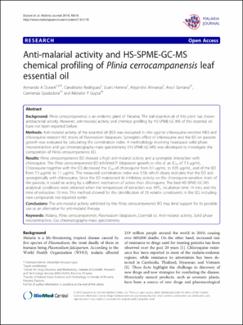Mostrar el registro sencillo del ítem
Anti-malarial activity and HS-SPME-GC-MS chemical profiling of Plinia cerrocampanensis leaf essential oil
| dc.contributor.author | Durant, Armando A | |
| dc.contributor.author | Rodríguez, Candelario | |
| dc.contributor.author | Herrera, Liuris | |
| dc.contributor.author | Almanza, Alejandro | |
| dc.contributor.author | Santana, Ana I | |
| dc.contributor.author | Spadafora, Carmenza | |
| dc.contributor.author | Gupta, Mahabir P | |
| dc.date.accessioned | 2020-06-17T04:17:08Z | |
| dc.date.available | 2020-06-17T04:17:08Z | |
| dc.date.issued | 2014-01-13 | |
| dc.identifier.other | https://malariajournal.biomedcentral.com/articles/10.1186/1475-2875-13-18 | |
| dc.identifier.uri | http://repositorio-indicasat.org.pa/handle/123456789/84 | |
| dc.description | Background Plinia cerrocampanensis is an endemic plant of Panama. The leaf essential oil of this plant has shown antibacterial activity. However, anti-malarial activity and chemical profiling by HS-SPME-GC-MS of this essential oil have not been reported before. Methods Anti-malarial activity of the essential oil (EO) was evaluated in vitro against chloroquine-sensitive HB3 and chloroquine-resistant W2 strains of Plasmodium falciparum. Synergistic effect of chloroquine and the EO on parasite growth was evaluated by calculating the combination index. A methodology involving headspace solid phase microextraction and gas chromatography-mass spectrometry (HS-SPME-GC-MS) was developed to investigate the composition of Plinia cerrocampanensis EO. Results Plinia cerrocampanensis EO showed a high anti-malarial activity and a synergistic interaction with chloroquine. The Plinia cerrocampanensis EO inhibited P. falciparum growth in vitro at an IC50 of 7.3 μg/mL. Chloroquine together with the EO decreased the IC50 of chloroquine from 0.1 μg/mL to 0.05 μg/mL, and of the EO from 7.3 μg/mL to 1.1 μg/mL. The measured combination index was 0.58, which clearly indicates that the EO acts synergistically with chloroquine. Since the EO maintained its inhibitory activity on the chloroquine-sensitive strain of the parasite, it could be acting by a different mechanism of action than chloroquine. The best HS-SPME-GC-MS analytical conditions were obtained when the temperature of extraction was 49°C, incubation time 14 min, and the time of extraction 10 min. This method allowed for the identification of 53 volatile constituents in the EO, including new compounds not reported earlier. Conclusions The anti-malarial activity exhibited by the Plinia cerrocampanensis EO may lend support for its possible use as an alternative for anti-malarial therapy. | en_US |
| dc.description.abstract | Background Plinia cerrocampanensis is an endemic plant of Panama. The leaf essential oil of this plant has shown antibacterial activity. However, anti-malarial activity and chemical profiling by HS-SPME-GC-MS of this essential oil have not been reported before. Methods Anti-malarial activity of the essential oil (EO) was evaluated in vitro against chloroquine-sensitive HB3 and chloroquine-resistant W2 strains of Plasmodium falciparum. Synergistic effect of chloroquine and the EO on parasite growth was evaluated by calculating the combination index. A methodology involving headspace solid phase microextraction and gas chromatography-mass spectrometry (HS-SPME-GC-MS) was developed to investigate the composition of Plinia cerrocampanensis EO. Results Plinia cerrocampanensis EO showed a high anti-malarial activity and a synergistic interaction with chloroquine. The Plinia cerrocampanensis EO inhibited P. falciparum growth in vitro at an IC50 of 7.3 μg/mL. Chloroquine together with the EO decreased the IC50 of chloroquine from 0.1 μg/mL to 0.05 μg/mL, and of the EO from 7.3 μg/mL to 1.1 μg/mL. The measured combination index was 0.58, which clearly indicates that the EO acts synergistically with chloroquine. Since the EO maintained its inhibitory activity on the chloroquine-sensitive strain of the parasite, it could be acting by a different mechanism of action than chloroquine. The best HS-SPME-GC-MS analytical conditions were obtained when the temperature of extraction was 49°C, incubation time 14 min, and the time of extraction 10 min. This method allowed for the identification of 53 volatile constituents in the EO, including new compounds not reported earlier. Conclusions The anti-malarial activity exhibited by the Plinia cerrocampanensis EO may lend support for its possible use as an alternative for anti-malarial therapy. | en_US |
| dc.language.iso | eng | en_US |
| dc.rights | info:eu-repo/semantics/openAccess | |
| dc.rights | https://creativecommons.org/licenses/by-nc-sa/4.0/ | |
| dc.subject | Malaria | en_US |
| dc.subject | Plinia cerrocampanensis | en_US |
| dc.subject | Plasmodium falciparum | en_US |
| dc.subject | Essential oil | en_US |
| dc.subject | Anti-malarial activity | en_US |
| dc.subject | Solid phase microextraction | en_US |
| dc.subject | Gas chromatography-mass spectrometry | en_US |
| dc.title | Anti-malarial activity and HS-SPME-GC-MS chemical profiling of Plinia cerrocampanensis leaf essential oil | en_US |
| dc.type | info:eu-repo/semantics/article | en_US |
| dc.type | info:eu-repo/semantics/publishedVersion |

